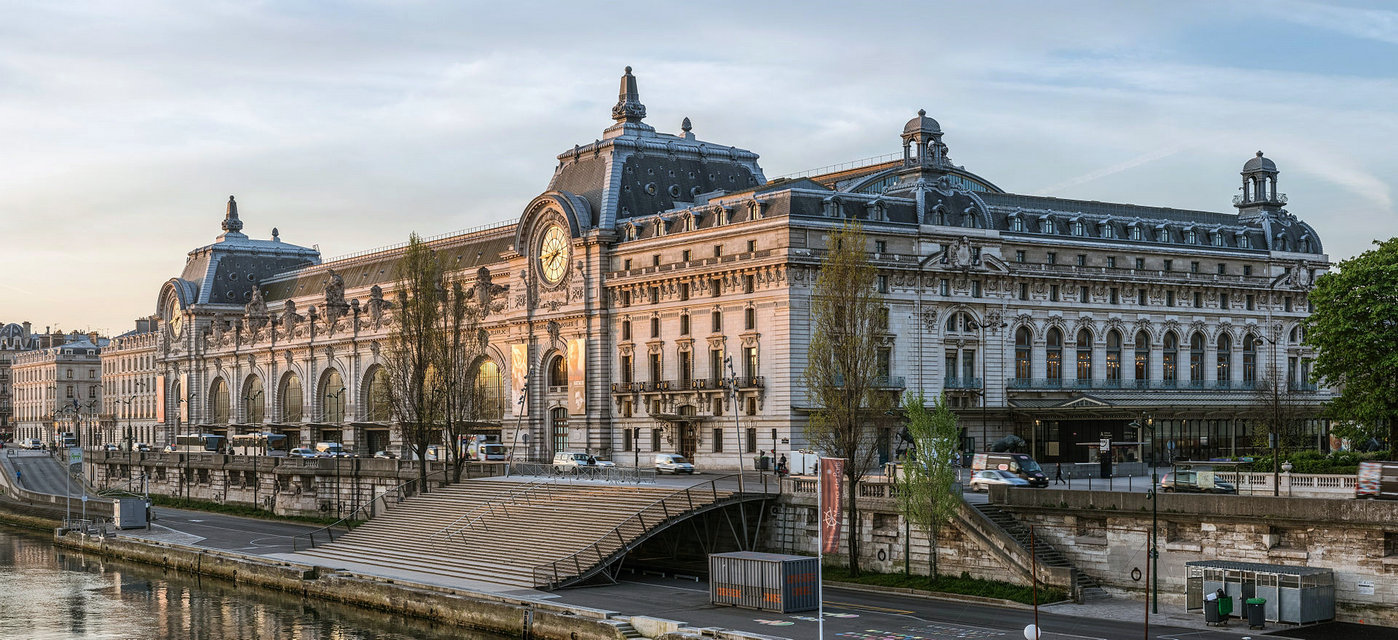The Musée d’Orsay is a national museum inaugurated in 1986, located in the 7th arrondissement of Paris, along the left bank of the Seine, in the old Orsay station built by Victor Laloux from 1898 to 1900, Restored as a museum, by decision of the President of the Republic Valéry Giscard d’Estaing. Its collections present Western art from 1848 to 1914, in all its diversity: painting, sculpture, decorative arts, graphic art, photography, architecture, etc. It is one of the largest museums in Europe.
The museum has the largest collection of Impressionist and Post-Impressionist paintings in the world, with nearly 1,100 paintings2 in total on more than 3,450, with masterpieces of painting and Sculpture such as The Lunch on the Grass and the Olympia by Edouard Manet, a test of La Petite Danseuse of fourteen years of Degas, The Origin of the World, A funeral in Ornans, The Workshop of the Painter of Courbet, Players Of Cézanne’s cards or five paintings from the Monet’s Rouen Cathedral Series and the Renoir’s Galette Mill Ball.
Temporary exhibitions illuminate periodically the work of an artist, or showcase a current, a merchant, a question of art history. An auditorium hosts diverse events, concerts, cinema, shadow theater, conferences and symposiums and shows specifically aimed at a young audience.
The history of the museum, of its building is quite unusual. In the centre of Paris on the banks of the Seine, opposite the Tuileries Gardens, the museum was installed in the former Orsay railway station, built for the Universal Exhibition of 1900. So the building itself could be seen as the first “work of art” in the Musee d’Orsay, which displays collections of art from the period 1848 to 1914.
Inaugurated at the Marsan Pavilion of the Louvre in 1905, the museum of decorative arts was considered in 1879 on the site attributed to the station d’Orsay in 1897, which eventually regained this museum vocation in 1986. The Gate of Hell Rodin, whose plaster is visible at the median level – Rodin terrace, was to constitute the monumental entrance.
As early as 1977, a collection of decorative arts objects from the period 1848-1914 was created at the Musée d’Orsay. Apart from the Charpentier dining room of 1900, restored in a clean space (period room), furniture and objects are shown out of context. Consisting of works representative of the production of ceramics, glassware, jewelery and furniture, this collection reflects the transformation of the production of art objects linked to the industrial revolution, the fine arts applied to the ” industry. It has a number of masterpieces that have long been unrecognized or poorly considered, and it also features pieces attesting to the exceptional quality of the luxury industries of that period. The museographical division of the collections of art objects distinguishes by their location those produced during the Second Empire (1852-1870) and in the first two decades of the Third Republic (1870-1940) from those corresponding to the Art Nouveau style From 1890).
The Musée d’Orsay exhibits and preserves the largest collection of impressionist paintings (more than 480 paintings) and post-impressionist paintings (more than 600 cloisonnist, neo-impressionist, symbolist, nabis …) and remarkable paintings Sets of Barbizon school paintings, realistic, naturalist, orientalist and academic, including foreign schools. Nearly 5,200 paintings make up the collection, but many works, including nearly 1,720 paintings, including a hundred unlocated or destroyed, are deposited in public buildings or provincial museums, such as 19 of the 95 paintings6 of Vuillard, 20 Of the 87 paintings of Bonnard, 19 of the 83 paintings of Renoir or 21 of the 69 paintings of Maurice Denis.
This non-exhaustive list lists the main painters represented in the Musée d’Orsay with the number of their paintings in the collections and the title of their main achievements, whether or not exposed, given the regular renewal of the clashes. This list also mentions the pastels, for the artists concerned: indeed, although not belonging to the department of paintings, a certain number of pastels are exhibited in the permanent collections of the museum.
